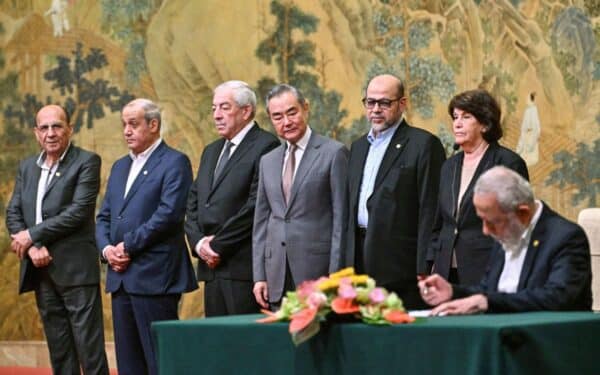As countries around the world consider how best to reopen their countries, it’s worth considering how South Korea has been able to “flatten the curve” and even hold parliamentary elections without resorting to lockdowns.
After seeing an initial spike in COVID-19 infections in February, South Korea implemented several measures to bring the disease’s spread under control, a progression I’ve followed as a researcher on public policy. South Korea was able to lower the number of new infections from 851 on March 3 to 22 infections as of April 17 and the mortality rate from COVID-19 hovers around 2%.
Several measures contribute to Korea’s success, but two measures were critical in the country’s ability to flatten the curve: extensive testing for the disease and a national system for promptly and effectively tracking people infected with COVID-19.
Testing and triage
From the 2015 MERS outbreak, Korea learned that infection to medical staff sapped the ability to control the virus as infected citizens in hospitals turned them into hotspots for infection. As a result, at the onset of COVID-19 infection, the Korean government ensured that proper personal protective equipment was provided to avoid infection to the medical staff. It also created physically separated testing and treatment sites for health care workers.
Once safe testing and treatment facilities were secured, the government began testing for COVID-19 at massive scale – over 440,000 people – which essentially covered all those with symptoms. People who test positive are quarantined in COVID-19 special units and treated.
South Korea focuses attention on treating people with severe symptoms and therefore less likelihood of recovery, rather than focusing on people with mild symptoms. This helped lower the mortality rate of COVID-19, as some of the most vulnerable populations with severe symptoms recovered. Countries focusing their effort on treating patients with a greater likelihood of survival may lead to a higher mortality rate as more vulnerable patients perish.
Extensive testing is a crucial step in identifying the state of the infection in the country – where the outbreaks are taking place, who is infected and who is not. This data then becomes a stepping stone for identifying any hotspots of infection in the country and to trace and identify the population that came in contact with those infected.
COVID-19 contact tracing system with roots in MERS
What distinguishes the Korean model in controlling COVID-19 is its ability to trace individuals diagnosed with the disease who may have come into contact with the infected individuals. It’s known as the COVID-19 Smart Management System (SMS).
South Korea’s Centers for Disease Control and Prevention (KCDC) runs the contact tracing system that uses data from 28 organizations such as National Police Agency, The Credit Finance Association, three smartphone companies, and 22 credit card companies to trace the movement of individuals with COVID-19. This system takes 10 minutes to analyze the movement of the infected individuals. For people who come in contact with an infected person, the KCDC informs the local public health center near the infected citizen’s residence and the health center sends the notification to them. If they test positive, they are hospitalized at the COVID-19 special facilities. Those without symptoms are asked to remain self-quarantined for 14 days.
The legal basis for accessing such personal information was prepared after the 2015 MERS outbreak when the government learned that tracing the movement of infected individuals and people who came in contact with them is crucial. As a safety measure, only epidemic investigators at KCDC can access the location information and once the COVID-19 outbreak is over, the personal information used for the contact tracing will be purged.
Could the US emulate South Korea?
South Korea’s model – relying on rapid testing availability, safe COVID-19 medical facilities and a government-run contact tracing system – helps avoid an authoritarian approach of shutting down an entire city as we have seen in China. A forced lockdown has democratic and human consequences of restricting individual freedom and stockpiling. It may have lasting consequences in the post-COVID-19 world such as the abuse of political power and the threat to freedom through intrusive surveillance.
Currently, the U.S. is considering re-opening the country or states out of concern over the economy. But without effective measures in place to contain the virus, it may lead to exponential growth in infection again.
Epidemiologists have said the key in defeating COVID-19 pandemic is in identifying hotspots of infection and severing the vicious cycle of infection. An effective contact tracing system is a crucial component in this approach and this can be potentially emulated in the U.S.
The U.S. has the necessary technology and data and the government could form a partnership with the relevant entities, such as credit card and telecommunications companies, law enforcement, health care, and other related public and private organizations to create a COVID-19 contact tracing system. With the help of such system, the government could identify the infected population and hotspots, trace and quarantine them for treatment in medical facilities that are, with government’s continued effort, supplied with the necessary PPE.
At the citizen level, the practice of wearing masks and social distancing should be strongly encouraged to prevent infection while the government tries to flatten the curve.
Currently, there is a sense of normalcy returning to South Korea. No cities are under lockdown, the restaurants, churches, bars, gyms and learning institutes are allowed to open if they observe the government quarantine guidelines, trains and buses run on schedule, grocery stores are fully stocked, and the country just successfully held parliamentary elections in mid-April. Citizens wear masks and exercise social distancing at all times which helps preventing further infection.
South Korea’s approach to COVID-19 with its focus on technology suggests a possible path for the U.S. in reopening the country without having to subject citizens to the coercive authority of the state and compromise our democratic ideal.




